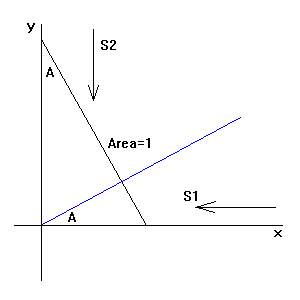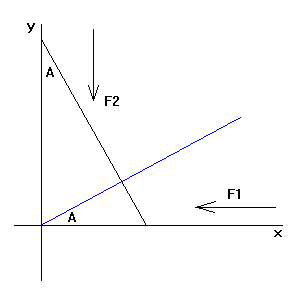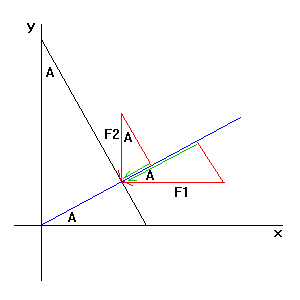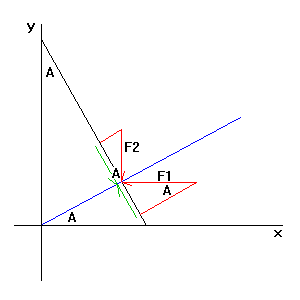The Mohr Circle
Steven Dutch, Professor Emeritus, Natural and Applied Sciences, University of Wisconsin - Green Bay
The Mohr Circle is a tremendously useful way to plot stress and strain. Unfortunately, to derive it, we have to plow through a bit of trigonometry first. In the example that follows, we'll assume:
- Compression is positive, tension is negative.
- The system is not rotating or moving (it might be, but we imagine ourselves moving along with it. We're only interested in the forces that are acting to deform the rock on a local scale).
- The stresses can be defined in terms of two perpendicular longitudinal stresses. We call this a principal axis system. For any stress system, we can always find a principal axis coordinate system.
Derivation of the Mohr Circle
 |
What stresses are acting on the inclined plane shown here? The stress parallel to the x-axis is S1, that parallel to the y-axis is S2. To simplify conversions between stress and force, we assume the plane has unit area. The pole to the plane (in blue) makes an angle A with the x-axis.
By the way, we define compression to be positive and tension as negative. |
 |
Unfortunately, stresses can't be added as vectors, only forces can. Because the plane is tilted, stress S1 "sees" only part of the plane. The cross-sectional area viewed along the x-axis is cos A. Similarly, stress S2 "sees" only a small part of the plane; the cross-sectional area viewed along the y-axis is sin A. Since force equals stress times area, the force F1 exerted parallel to the x-axis is S1 cosA, and the force F2 exerted parallel to the y-axis is S2 sinA.
|
 |
To find the force acting perpendicular (or normal) to the plane, we find the components of F1 and F2 perpendicular to the plane (green arrows). They are both acting in the same direction, so the total force is their sum. Thus: Normal Force = F1 cos A + F2 sin A |
 |
To find the force acting parallel to the plane (the shear force), we find the components of F1 and F2 parallel to the plane (green arrows). These are acting in opposite directions, so the total force is their difference. Thus: Shear Force = F1 sin A - F2 cos A |
From the above, we have
- Normal Force = F1 cos A + F2 sin A
- Shear Force = F1 sin A - F2 cos A
Also, both forces are acting on the entire plane, which means the stresses (force per unit area) have the same magnitude (though not the same units).
- Normal Stress = F1 cos A + F2 sin A (per unit area)
- Shear Stress = F1 sin A - F2 cos A (per unit area)
Also, we know that:
- F1 = S1 cos A
- F2 = S2 sin A
Therefore we can express the normal and shear stresses in terms of S1 and S2 as follows:
- Normal Stress = S1 cos A cos A + S2 sin A sin A
= S1 cos2 A + S2 sin2 A - Shear Stress = S1 cos A sin A - S2 sin A cos A
From elementary trigonometry, we recall the double-angle formulas:
- cos 2A = cos2 - sin2 = 1 - 2 sin2 = 2 cos2 - 1
- sin 2A = 2 sin A cos A
We can rearrange the terms to get:
- sin2 = (1 - cos 2A)/2
- cos2 = (cos 2A + 1)/2
- sin A cos A = (sin 2A)/2
Finally we can substitute functions of 2A into the equations for normal and shear stress to get:
- Normal Stress = S1(cos 2A + 1)/2 + S2(1 - cos 2A)/2
= (S1 + S2)/2 + ((S1 - S2)/2) cos 2A - Shear Stress = ((S1 - S2)/2) sin 2A
Now the equation for a circle with center (p,0) and radius r is
- x = p + r cos t
- y = r sin t
These formulas are identical in form to the formulas for normal and shear stress. Thus, if we draw a graph of normal and shear stress and plot all the normal and shear stresses for every value of A, they would plot on a circle whose center is (S1 + S2)/2 and whose radius is (S1 - S2)/2. This circle is called the Mohr Circle.
Real Space and Mohr Space

In the diagram above, a plane subject to stresses S1 and S2 is shown at left and the Mohr Circle calculation of the stresses on the plane at right. Choose a suitable scale and plot S1 and S2 on the horizontal axis. Draw a circle centered on the midpoint between S1 and S2 and passing through both. If the pole to the plane makes an angle A with the S1 direction, measure off 2A on the Mohr Circle. Point X represents the stress on the plane, with normal stress measured horizontally and shear measured vertically (green lines).
Three Fundamental Principles of Mohr Circles
- Directions of planes are always represented by their poles
- Angles on the Mohr Circle are double the corresponding angles in real life.
- Always measure angles in the same sense in both real life and on Mohr Circles
Where do Angles From 180 to 360 Go?
Since angles are doubled on the Mohr Circle, any angles in real life greater than 180 degrees will be greater than 360 on the Mohr Circle. They will simply repeat themselves. This is not a problem, because any stress system not involving rotation is symmetrical. We could perform stress calculations for a plane oriented 180 degrees from the plane in the diagram and the results would be identical. In fact, the pole to the plane would be identical - the plane would merely be facing in the opposite direction. Thus stresses on a plane oriented at angle A and one at 180+A are identical. Thus an angle 2A on the Mohr Circle can also represent an angle 360+2A (corresponding to a plane whose pole has azimuth 180+A).
What Does the Bottom Half of the Mohr Circle Represent?
If we define positive normal stress as compression, then negative normal stress is obviously tension. Similarly, above the horizontal axis represents positive shear, and below represents negative. Only what exactly do positive and negative shear stress mean?

In the example we've been using, S1 is the larger stress and, given the tilt of the plane, slippage would tend to be left lateral if it were a fault. On this Mohr Circle, then, positive shear means left-lateral slip. If we were to flip the diagram vertically, we'd have right-lateral slip and negative shear.
But suppose we're looking at a dip-slip fault. Positive shear would correspond to thrust faulting, negative shear to normal faulting.
Whatever the orientation of the fault, when slip occurs on the plane shown, it will result in counterclockwise rotation. For this diagram, then, positive is counterclockwise and negative is clockwise.
However, we cannot give a universal definition because different workers define the signs of stresses differently. All we can say is that positive and negative shear correspond to the different senses of shear motion (right lateral-left lateral, normal-thrust, clockwise-counterclockwise). The only sure way to ascertain which is which is to work from the real-world stress situation and see where each type of shear plots on the Mohr Circle. Often we don't worry about the sense of shear and simply portray only the top half of the Mohr Circle to save space.
A Useful Tip: Recall that Shear Stress = ((S1 - S2)/2) sin 2A. Now we have defined terms so that S1 is always greater than S2, and sin 2A is always positive for A < 90 degrees. So in the real-world diagrams above, shear is always positive. Now if S2 = 0, then only S1 can exert a shear force on the plane. Therefore the shear sense is always determined by the larger stress. So ignore the smaller stress and observe which way the larger stress is pushing rocks on either side of the plane.
About Sign Conventions
There are two sign conventions for stress in use in structural geology:
- Since most stresses in geology are compressional, many workers prefer to define compression as positive and tension as negative.
- In situations where mathematical consistency is important, especially in more theoretical studies, it's best to define positive vectors as pointing in the positive axis direction. Thus positive stress points in the positive x-direction, away from the origin. In this system, tension is positive and compression is negative.
To quote the Hitchhiker's Guide to the Galaxy, don't panic. Mohr Circles work equally well in either convention. Just be sure you know which convention is in use, follow it consistently, and always measure angles on the Mohr Circle in the same sense as in real life.
Return to Course Syllabus
Return to Techniques Manual Index
Return to Professor Dutch's Home Page
Created 13 May 1999, Last Update 13 May 1999